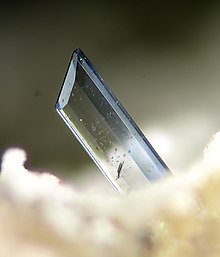| Vivianite | |
|---|---|
 Vivianite tabular crystal, transparent, with a deep green color. Crystal size: 82 mm × 38 mm × 11 mm. From Huanuni mine, Dalence Province, Oruro Department, Bolivia | |
| General | |
| Category | Phosphate mineral Vivianite group |
| Formula (repeating unit) | Fe2+ 3(PO 4) 2·8H 2O |
| IMA symbol | Viv[1] |
| Strunz classification | 8.CE.40 (10 ed) 7/C.13-40 (8 ed) |
| Dana classification | 40.3.6.1 |
| Crystal system | Monoclinic |
| Crystal class | Prismatic (2/m) (same H-M symbol) |
| Space group | C2/m |
| Unit cell | a = 10.086 Å, b = 13.441 Å c = 4.703 Å; β = 104.27°; Z = 2 |
| Identification | |
| Formula mass | 501.61 g/mol |
| Color | Colorless, very pale green, becoming dark blue, dark greenish blue, indigo-blue, then black with oxidation |
| Crystal habit | Flattened, elongated prismatic crystals, may be rounded or corroded; as stellate groups, incrustations, concretionary, earthy or powdery |
| Twinning | Translation gliding |
| Cleavage | Perfect on {010} |
| Fracture | Fibrous |
| Tenacity | Flexible, sectile |
| Mohs scale hardness | 1.5–2 |
| Luster | Vitreous, pearly on the cleavage, dull when earthy |
| Streak | White, altering to dark blue, brown |
| Diaphaneity | Transparent to translucent |
| Specific gravity | 2.68 |
| Optical properties | Biaxial (+); moderate relief |
| Refractive index | nα = 1.579–1.616, nβ = 1.602–1.656, nγ = 1.629–1.675[2] |
| Birefringence | δ = 0.050–0.059 |
| Pleochroism | Visible; X = blue, deep blue, Indigo-blue; Y = pale yellowish green, pale bluish green, yellow-green; Z = pale yellowish green, olive-yellow |
| 2V angle | Measured: 63° to 83.5°, Calculated: 78° to 88° |
| Dispersion | r < v, weak |
| Ultraviolet fluorescence | Not fluorescent |
| Melting point | 1,114 °C (2,037 °F) |
| Solubility | Easily soluble in acids |
| Alters to | Metavivianite |
| References | [2][3][4] |




Vivianite (Fe(II)
3(PO
4)
2·8H
2O) is a hydrated iron(II) phosphate mineral found in a number of geological environments. Small amounts of manganese Mn2+, magnesium Mg2+, and calcium Ca2+ may substitute for iron Fe2+ in its structure.[5] Pure vivianite is colorless, but the mineral oxidizes very easily, changing the color, and it is usually found as deep blue to deep bluish green prismatic to flattened crystals. Vivianite crystals are often found inside fossil shells, such as those of bivalves and gastropods, or attached to fossil bone. Vivianite can also appear on the iron coffins or on the corpses of humans as a result of a chemical reaction of the decomposing body with the iron enclosure.[6]
It was named by Abraham Gottlob Werner, the "father of German geology", in 1817, the year of his death, after either John Henry Vivian (1785–1855), a Welsh-Cornish politician, mine owner and mineralogist living in Truro, Cornwall, England, or after Jeffrey G. Vivian, an English mineralogist.[7] Vivianite was discovered at Wheal Kind, in St Agnes, Cornwall.[3]
- ^ Warr, L.N. (2021). "IMA–CNMNC approved mineral symbols". Mineralogical Magazine. 85 (3): 291–320. Bibcode:2021MinM...85..291W. doi:10.1180/mgm.2021.43. S2CID 235729616.
- ^ a b Cite error: The named reference
Handbookwas invoked but never defined (see the help page). - ^ a b Cite error: The named reference
Mindatwas invoked but never defined (see the help page). - ^ Cite error: The named reference
Webminwas invoked but never defined (see the help page). - ^ Gaines et al (1997) Dana's New Mineralogy Eighth Edition. Wiley
- ^ Cite error: The named reference
Atlasobswas invoked but never defined (see the help page). - ^ Although mindat.org claims "J. G. Vivian" is a typo for "J. H. Vivian", there is at least one reference that gives a full first name. The original description of Vivianite in Abraham Gottlob Werner, Letztes Mineral-System, Freiberg/Wien, 1817, p. 42 reads „Der Name ist vom Hrn. B. R. Werner zu Ehren des Hrn. J. Vivian aus Truro in Cornwall, dem Er die Kentnis des Fossils verdankt, gebildet.“ [“The name is formed by Mr. B. R. Werner in honour of Mr. J. Vivian from Truro in Cornwall, to whom he owes the memory of the fossil.”] It is ambiguous (and puzzling in its reference to B. R. Werner). As for Jeffrey G. Vivian, no other trace of him can be found in Google Books.